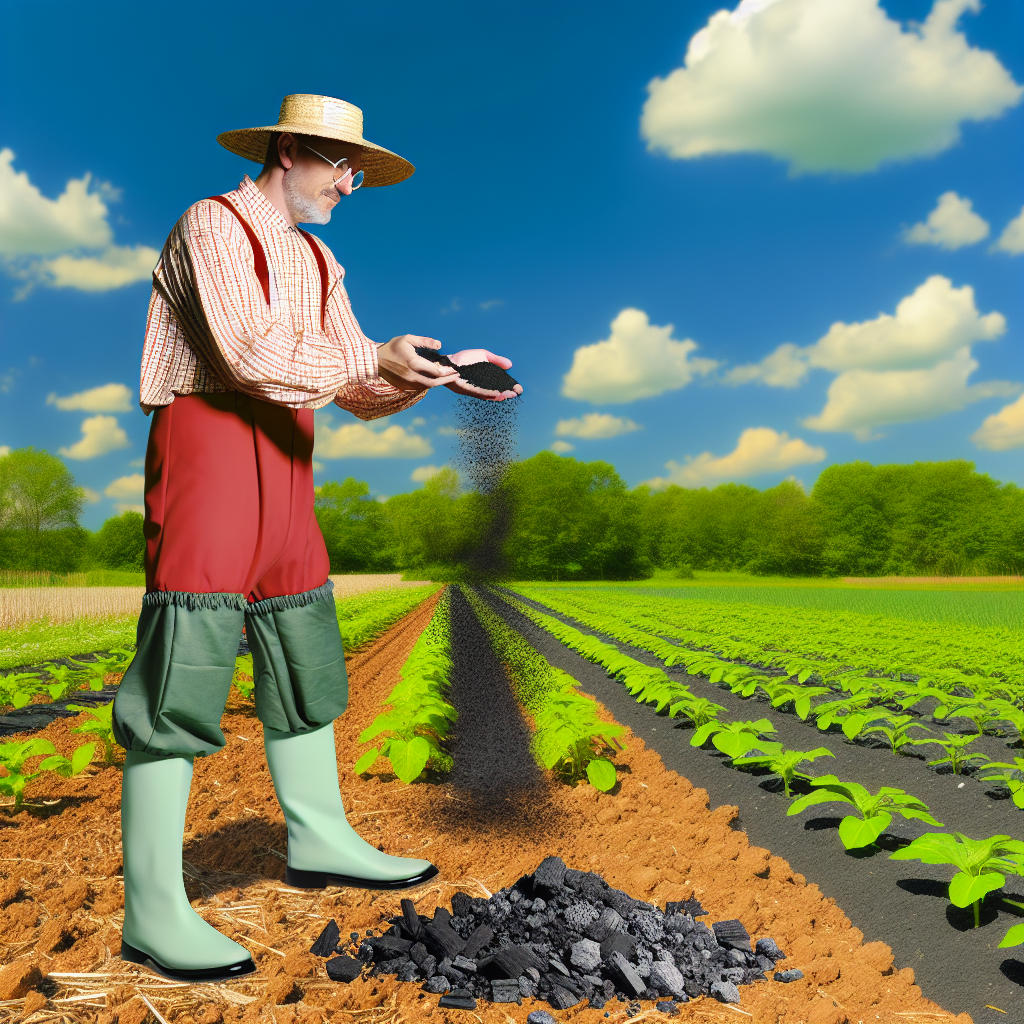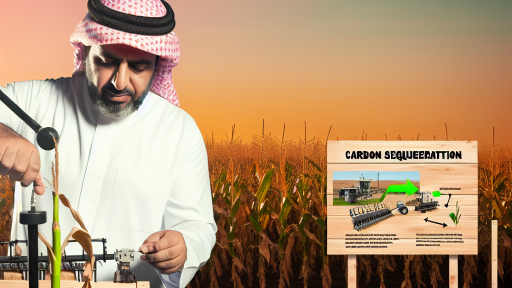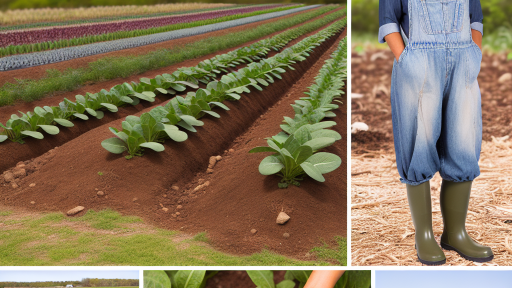Introduction to Biochar
Definition of Biochar
Biochar is a charcoal-like substance produced from organic materials.
It is created through pyrolysis, a process that decomposes biomass under limited oxygen.
This process results in a stable carbon-rich product that benefits soil health.
Historical Context of Biochar
The use of biochar dates back thousands of years.
Ancient civilizations in the Amazon used it to enhance soil fertility.
Known as terra preta, these enriched soils supported agriculture for centuries.
Recently, biochar has gained attention for its potential to improve carbon storage.
Modern Applications and Interest
Today, farmers and researchers are exploring biochar’s properties.
They study its benefits for both agriculture and environmental sustainability.
This interest has sparked innovations in biochar production and application methods.
As a result, more agricultural systems are incorporating biochar effectively.
The Science of Carbon Storage: How Biochar Functions in Soil
Introduction to Biochar
Biochar is a carbon-rich material produced from organic matter.
This process, known as pyrolysis, involves heating biomass in low-oxygen conditions.
As a result, biochar sequesters carbon for extended periods in the soil.
Farmers and scientists increasingly recognize its benefits for sustainable agriculture.
Transform Your Agribusiness
Unlock your farm's potential with expert advice tailored to your needs. Get actionable steps that drive real results.
Get StartedMechanisms of Carbon Storage
Biochar aids in carbon storage through various mechanisms.
First, it increases soil organic carbon levels significantly.
Moreover, biochar enhances soil structure, promoting water retention.
Consequently, it improves nutrient availability for plants.
This leads to healthier crops and increased yield.
Improved Soil Microbial Activity
Biochar influences the soil microbiome positively.
It provides habitat for beneficial microorganisms.
These microbial communities enhance nutrient cycling and organic matter decomposition.
As a result, they contribute to soil health and fertility.
Reduction of Soil Erosion
Soil erosion poses a significant threat to carbon storage.
Biochar mitigates erosion by improving soil structure.
It helps stabilize soil aggregates, reducing runoff.
This stabilization allows for greater carbon retention over time.
Impacts on Greenhouse Gas Emissions
Biochar can significantly reduce greenhouse gas emissions.
It lowers nitrogen oxide emissions by retaining nitrogen in the soil.
Furthermore, it minimizes methane production from anaerobic conditions.
Thus, implementing biochar in agriculture contributes to climate change mitigation.
Successful Case Studies
Numerous case studies demonstrate biochar’s effectiveness in agriculture.
A study in Brazil showed increased corn yields with biochar amendment.
Similarly, experiments in Kenya revealed enhanced soil fertility and crop performance.
These examples illustrate biochar’s potential to transform farming practices.
Future Directions for Biochar Utilization
Increased research into biochar application methods is essential.
Exploring new biomass sources can enhance the carbon benefits of biochar.
Policy support can foster wider adoption in agricultural systems.
Showcase Your Farming Business
Publish your professional farming services profile on our blog for a one-time fee of $200 and reach a dedicated audience of farmers and agribusiness owners.
Publish Your ProfileBenefits of Biochar in Agriculture: Enhancing Soil Fertility and Structure
Improved Soil Fertility
Biochar significantly enhances soil fertility.
It adds essential nutrients to the soil.
This includes nitrogen, phosphorus, and potassium.
Consequently, plants receive better nourishment.
Moreover, biochar enhances the soil’s ability to retain nutrients.
Soil Structure Improvement
Biochar contributes to improved soil structure.
It helps create a stable aggregation of soil particles.
This stability allows for better air circulation.
Additionally, it promotes root growth in plants.
Furthermore, good soil structure enhances water infiltration.
Water Retention Capacity
Biochar increases the soil’s water retention capacity.
It holds moisture more effectively than regular soil.
This reduces the need for frequent watering.
As a result, it benefits crops during dry spells.
Consequently, farmers can conserve water efficiently.
Microbial Activity Boost
Incorporating biochar encourages beneficial microbial activity.
It creates a suitable habitat for soil microorganisms.
These microbes play a crucial role in nutrient cycling.
They help decompose organic matter effectively.
As a result, increased microbial activity benefits plant growth.
Reduction of Soil Acidity
Biochar can help reduce soil acidity levels.
Lower acidity enhances nutrient availability for plants.
Moreover, it can improve overall crop yield.
This is especially beneficial in acidic soils.
Farmers can produce healthier plants through biochar application.
See Related Content: Adapting Farming Practices to Changing Water Patterns
Different Methods of Biochar Production
Overview of Biochar Production
Biochar production involves various techniques.
These methods transform organic materials into carbon-rich products.
The choice of technique impacts the biochar’s properties.
Therefore, understanding production methods is vital.
Pyrolysis
Pyrolysis is a widely used biochar production method.
It consists of heating biomass in an anaerobic environment.
This process occurs at high temperatures, typically between 300 and 900 degrees Celsius.
During pyrolysis, organic materials decompose chemically.
Gas, bio-oil, and solid char are produced as byproducts.
The solid char becomes biochar, which can enhance soil conditions.
Benefits of Pyrolysis
Pyrolysis offers numerous advantages for biochar production.
- It produces a stable form of carbon that enhances soil quality.
- The process can utilize various types of biomass.
- Pyrolysis minimizes greenhouse gas emissions compared to burning.
- It enables energy recovery from the resulting bio-oil and gas.
Gasification
Gasification is another method for producing biochar.
This process involves partially oxidizing feedstocks at high temperatures.
Typically, it also operates in a low-oxygen environment.
Showcase Your Farming Business
Publish your professional farming services profile on our blog for a one-time fee of $200 and reach a dedicated audience of farmers and agribusiness owners.
Publish Your ProfileGasification produces syngas, a mixture of hydrogen and carbon monoxide.
Additionally, it creates biochar as a solid residue.
Benefits of Gasification
Gasification presents its own set of benefits.
- It efficiently converts organic matter into useful gases.
- This method produces a smaller amount of char compared to pyrolysis.
- Gasification allows for energy recovery from syngas.
- The process can be integrated into existing energy systems.
Comparison of Pyrolysis and Gasification
Both methods have unique features and outputs.
Pyrolysis emphasizes the production of solid biochar.
In contrast, gasification focuses on energy generation from syngas.
Consequently, the choice between them depends on specific goals.
Farmers should consider their resources and intended applications.
Find Out More: Top Farming Methods to Handle Climate Shifts
Application Techniques
Understanding Biochar Properties
Biochar improves soil properties significantly.
It enhances soil structure and moisture retention.
Additionally, biochar promotes beneficial microbial activity.
Preparation of Biochar
Start by selecting the right feedstock material.
Common options include wood chips, straw, and other organic residues.
Next, ensure proper pyrolysis conditions for optimal biochar quality.
This process should control temperature and oxygen levels.
Incorporation Methods
Add biochar to soil before planting crops.
You can till it into the topsoil for better integration.
Alternatively, you can mix it with compost to enhance nutrient content.
Consider applying it as a mulch layer in gardens.
Timing and Frequency of Application
Schedule biochar applications during the off-season.
This timing allows for better soil preparation.
Apply biochar at least once a year for sustainable results.
Adjust frequency based on crop rotation and soil tests.
Monitoring and Evaluation
Regularly assess soil health and crop performance.
Keep records of application rates and methods used.
This data helps in refining future biochar strategies.
Engage with agronomists to understand the long-term impacts.
Community and Collaboration
Join local workshops or farmer groups engaging with biochar.
Collaborate on research initiatives related to biochar applications.
Share experiences for improved practices and results.
Networking fosters innovation in biochar use in agriculture.
Gain More Insights: Rainwater Harvesting Strategies for Modern Farms
Case Studies: Successful Biochar Implementation in Various Agricultural Settings
Biochar Use in Corn Farming
A corn farm in Iowa implemented biochar for soil enhancement.
The results showed significant increases in yield and soil health.
Farmers reported improved water retention and nutrient availability.
This practice led to more sustainable farming over the long term.
Biochar Benefits for Organic Vegetable Production
A small organic farm in California utilized biochar to enrich its soils.
The farmers noticed enhanced microbial activity within weeks.
Soil tests revealed increased carbon content due to biochar application.
Showcase Your Farming Business
Publish your professional farming services profile on our blog for a one-time fee of $200 and reach a dedicated audience of farmers and agribusiness owners.
Publish Your ProfileThis method also reduced the need for chemical fertilizers.
Biochar in Coffee Cultivation
A coffee plantation in Colombia experimented with biochar as a soil amendment.
Results indicated improved coffee quality and plant vigor.
The addition of biochar reduced erosion on sloped terrains.
Furthermore, it contributed to higher carbon sequestration rates.
Biochar for Rice Farming
A rice producer in Thailand adopted biochar to tackle soil salinity issues.
This application successfully improved soil structure and health.
In turn, plants showed enhanced growth and resistance to pests.
This case highlights biochar’s potential in alleviating specific agricultural challenges.
Collaborative Research Initiatives
Various universities and research institutions study biochar applications.
These initiatives focus on diverse agricultural systems across the globe.
The data collected supports the viability of biochar for carbon storage.
Additionally, researchers encourage farmers to adopt these practices.
You Might Also Like: Farmers’ Climate Change Adaptation Cheat Sheet

Economic Considerations
Cost-Benefit Analysis of Biochar Use in Agriculture
Understanding the economic impact of biochar is essential for farmers.
First, it involves evaluating initial costs versus long-term benefits.
Biochar production requires investment in equipment and feedstock.
Yet, many farmers find that benefits outweigh these initial costs.
For instance, biochar improves soil fertility significantly.
Enhanced fertility leads to increased crop yields.
Consequently, farmers can earn more from their harvests.
Moreover, biochar mitigates climate change by sequestering carbon.
This results in potential carbon credits for eco-conscious farmers.
Farmers like Sarah Jennings have successfully adopted biochar.
Her crop production increased by 20% after implementation.
Additionally, biochar reduces the need for chemical fertilizers.
This further lowers operational costs for farmers.
Market Analysis
In assessing biochar’s economic viability, market demand plays a role.
The global biochar market is anticipated to grow substantially.
Increased awareness of soil health promotes biochar adoption.
Farmers can attract premium prices for organically grown produce.
Simultaneously, demand for carbon credits continues to rise.
Subsequently, farmers can diversify income through carbon trading.
Financial Support and Incentives
Governments and organizations now offer funds to support biochar projects.
Many grant programs assist with costs related to biochar production.
Additionally, financial incentives encourage sustainable agricultural practices.
Farmers should research available grants and funding opportunities.
They can consult local agricultural extension offices for assistance.
Long-Term Economic Benefits
Ultimately, biochar provides several long-term economic advantages.
Firstly, it improves soil structure, enhancing water retention.
Showcase Your Farming Business
Publish your professional farming services profile on our blog for a one-time fee of $200 and reach a dedicated audience of farmers and agribusiness owners.
Publish Your ProfileThis means reduced irrigation costs for farmers.
Secondly, biochar fosters beneficial microbial communities in the soil.
This leads to healthier crops and reduced disease incidence.
Furthermore, improved soil health promotes sustainable farming practices.
As a result, farmers maintain productivity for future generations.
Ultimately, investing in biochar creates a balanced approach to agriculture.
The economic advantages can support farmers and our environment.
Challenges and Limitations
Understanding the Issues
Biochar implementation faces several challenges in agricultural settings.
First, the production process of biochar can be resource-intensive.
Moreover, sourcing sustainable feedstock remains a critical concern.
Additionally, the pyrolysis process may release greenhouse gases.
Consequently, life cycle assessments are necessary to quantify impacts.
Soil Compatibility Concerns
Another challenge involves the compatibility of biochar with various soil types.
Different soils may react differently to biochar applications.
Thus, it is essential to conduct site-specific assessments.
Moreover, initially improving soil fertility can lead to variable long-term effects.
As a result, farmers need to monitor changes over time.
Regulatory and Economic Barriers
Biochar use often faces regulatory hurdles and economic limitations.
Current regulations may not adequately support biochar applications.
Additionally, farmers may be deterred by the upfront costs.
To address this, governmental incentives could play a crucial role.
Consequently, collaborations with regulatory bodies may enhance feasibility.
Public Perception and Knowledge Gaps
Public acceptance is another significant hurdle for biochar integration.
Many individuals have limited knowledge about biochar’s benefits.
This lack of understanding can lead to skepticism about its effectiveness.
To counteract this, educational campaigns are imperative.
Ultimately, increasing awareness can encourage sustainable practices.
Environmental Impacts
While biochar offers numerous benefits, potential negative impacts exist.
For instance, improper application can lead to nutrient leaching.
Furthermore, biochar may influence local ecosystems unpredictably.
Thus, thorough environmental assessments must precede widespread adoption.
Careful considerations can mitigate these risks.
Future Perspectives: Research and Innovations in Biochar Technology
Emerging Research Trends
Researchers are increasingly focusing on the benefits of biochar in agriculture.
Studies showcase its potential to enhance soil fertility significantly.
Moreover, they explore biochar’s role in improving water retention in soils.
Recent projects emphasize the importance of using local feedstocks for biochar production.
Innovative Production Techniques
Advanced technology is transforming biochar production processes.
For instance, pyrolysis methods are being optimized for better yields.
Innovations include techniques that reduce energy consumption during production.
Additionally, researchers are investigating microwave-assisted pyrolysis for efficiency.
Showcase Your Farming Business
Publish your professional farming services profile on our blog for a one-time fee of $200 and reach a dedicated audience of farmers and agribusiness owners.
Publish Your ProfileIntegration with Other Agricultural Practices
Integrating biochar with permaculture practices shows immense potential.
This combination improves soil health while enhancing biodiversity.
Furthermore, it explores the synergies between biochar and organic farming.
Such integrations promote a holistic approach to sustainable agriculture.
Carbon Sequestration and Climate Mitigation
Biochar plays a crucial role in carbon sequestration strategies.
It offers a viable solution to combat climate change effectively.
Research indicates significant carbon retention over long periods.
As a result, biochar contributes to reduction of greenhouse gas emissions.
Market Development and Economic Implications
The biochar market is gradually expanding, reflecting increased demand.
Various initiatives aim to support farmers adopting biochar practices.
Government grants and subsidies encourage research and production efforts.
Consequently, the economic viability of biochar continues to improve.
Future Collaborations and Partnerships
Partnerships between universities and agricultural organizations are crucial.
Collaborative research efforts yield innovative solutions for farmers.
Additionally, industry alliances help standardize biochar production quality.
Such collaborations promote knowledge sharing and maximize impact.
Additional Resources
Scaling Sustainable Biochar Research & Commercialization for …
South Carolina fescue farmers needed for climate-smart agriculture …




